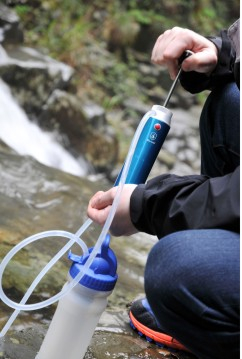對於救人,特別是這次四川災區有一種黃金72小時準則,就是救人必需趕在黃金72小時之內.這72小時是寸金寸光陰,快一分鐘就可以多救一個人。這跟人的身體有關,人可以72小時不吃飯但是絕對不可以72小時不喝水.但是一但發生巨大的自然災害,純凈的水源都會受汙染.這時候幹凈的水就是個大問題了。
The Lifesaver is a water bottle–but not just any water bottle. Through "an advanced ultra-filtration membrane that incorporates a high specification carbon block" it can convert dirty water to clean in a matter of seconds–you put in the water, pump it through the filter a few times, then drink. The cartridge is supposed to be able to filter out waterborne pathogens and eliminate bad tastes and odors, too. The replaceable cartridge has a filtering capacity of 4,000 to 6,000 litres, so it’s not short-lived: 700 litres is a year’s supply of water for one person. The military is interested, naturally, but an even more important application would be to supply clean drinking water after disasters such as the Boxing Day tsunami in 2004 or Hurricane Katrina: instead of distributing bottled water, you could distribute bottles that clean the water that’s at hand. And even in the absence of disasters, access to clean water is a worldwide problem. Hmmm. My daughter’s water bottle is starting to smell funny. Maybe I should be getting her one of these… Or maybe the Lifestraw is the way to go. It’s a plastic pipe filter 25 centimetres long and 29 millimetres in diameter that costs just a few dollars and can purify up to 700 litres of water.A word of advice, though: when giving a Lifestraw to a suffering disaster victim, find a different way to instruct him in its use than telling him to "suck it up."
申明:本站發佈所有文章、圖片資源内容,如無特殊説明或標注,均爲采集或轉發網絡資源。如若本站所發之内容侵犯了原著者或所有權主體的合法權益,可聯絡本站刪除。







![蛇傷處理好裝備--sawyer吸取器功能介紹[圖]](http://www.571400.cn/pictures/20120824/201208240841072148.jpg)

![折疊式設計 休閑是用--大號的行軍床[組圖]](http://www.571400.cn/pictures/20120824/201208240839132019.jpg)